By way of beta testing the ability of my newly-printed postcards to withstand the travails of the postal system, I mailed one to myself on Tuesday afternoon; it arrived in this morning’s mail, two days later.
Setting aside that it took 48 hours for the postcard to travel from 101 Prince Street to 100 Prince Street–because the mail is processed in Halifax now, 300 km away–I was dismayed to receive the postcard with the stamp “cancelled” by a stroke of a ballpoint pen and missing a postmark completely:
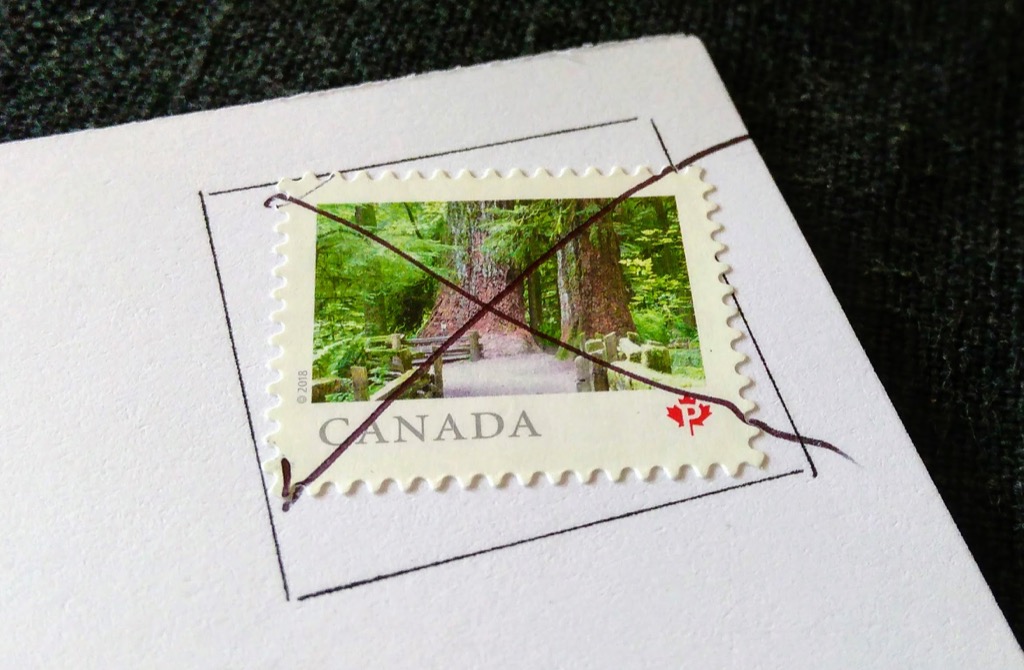
Not only are the aesthetics of this offensive, but the lack of a postmark removes any formal record of the postcard having traveled through the mail at all.
My postal sources tell me that the likely reason for the pen-cancellation is that the postcard could not be mechanically sorted, needed to be hand-processed, and the postal worker who did the processed was not equipped with a cancellation stamp.
Even when this doesn’t happen, and the robots can do the sorting, the postmark and cancellation applied are for Nova Scotia, not Prince Edward Island, resulting in a troubling absence of postal sovereignty.
The same sources tell me that I can take mail to the central post office on Kent Street to be hand-cancelled; that’s my next test.
Frank Meeuwsen writes about the upcoming European GDPR and how its provisions might apply to personal websites (in Dutch). While he concludes that the GDPR does not apply to sites like his, he suggests that the spirit of the GDPR is something to aspire to, regardless (auto-translated):
Nevertheless, I do not think it’s a bad idea to give more clarity and transparency [to] what I store on my site and for what reason. Starting with the statistics.
This is something I’ve been thinking a lot about as well. Over recent years I’ve taken steps to evermore completely remove any tracking or data gathering from this site, removing third-party JavaScript, removing Google Analytics, turning off all advertising, changing my webserver logs to remove IP address logging. So much of what I was previously gathering, much of it simply “on by default,” technically or by convention, was of no use to me, so I’ve suffered no ill from these changes.
In the same spirit of codifying transparency that Frank demonstrates in his post, I’ve been working away at a Privacy Policy for this site. It’s a work in progress, and I’m trying to balance completeness with readability (and, for the moment, completeness is winning).
(I’d completely forgotten that Frank posted videos of the Reboot conference Pecha Kucha sessions back in 2006, including my own. Apparently I’ve been interested in public data for a very long time.)
Many years ago, my friend Dan made a robot to answer telemarketers, an effort that presaged Google Duplex, but without the pesky need for the AI.
The story of how Anne Marie Hagan forgave the man who killed her father, told to the CBC’s Piya Chattopadhyay on the May 6 episode of Out in the Open, is one of the most powerful pieces of radio I’ve heard in a long time.
Of all the things I’ve designed, set and printed for letterpress, this might be my favourite: a Prince Edward Island postcard.
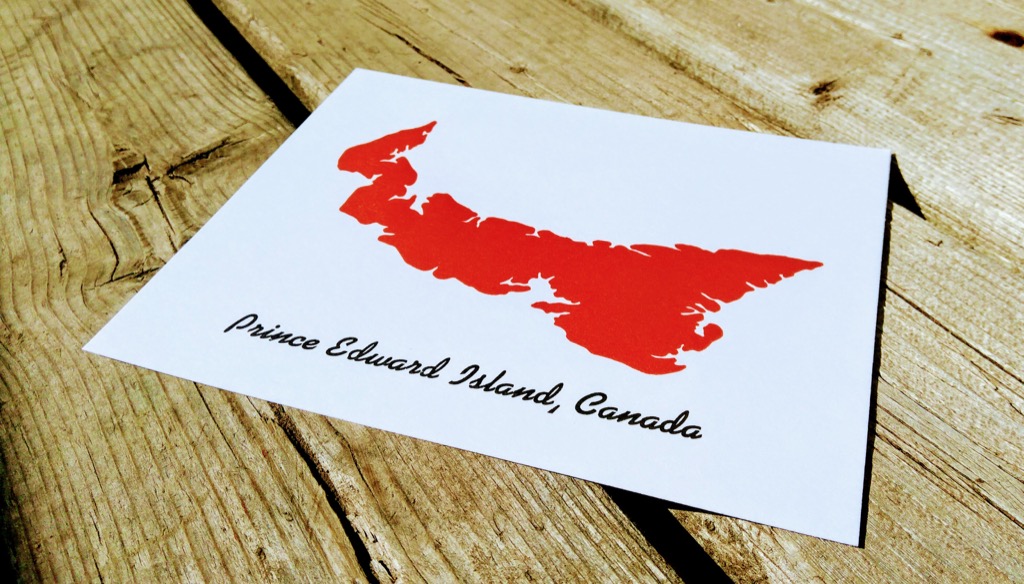
The outline of the Island comes from the collection of letterpress cuts passed on to me by Ian Scott and Daphne Large.
The typeface is a font of Kaufman Bold one that artist Jennifer Brown pulled out of her garage for me, helpfully sorted for use by Christina Clorey. McGrew describes the face, designed by Max R. Kaufmann for American Type Founders in 1936, as having a “contemporary look and high degree of legibility,” which is certainly a quality we should all aspire to in all regards (you may recognize it from “with David Letterman” on the marquee of the Ed Sullivan Theatre in New York City).
On the reverse side–this is a postcard, after all, and deserved the usual accoutrements–is a “Printed on a 1915 Golding letterpress in Charlottetown” caption, a line-rule down the middle to separate message from address, and a box to indicate where the stamp should go:
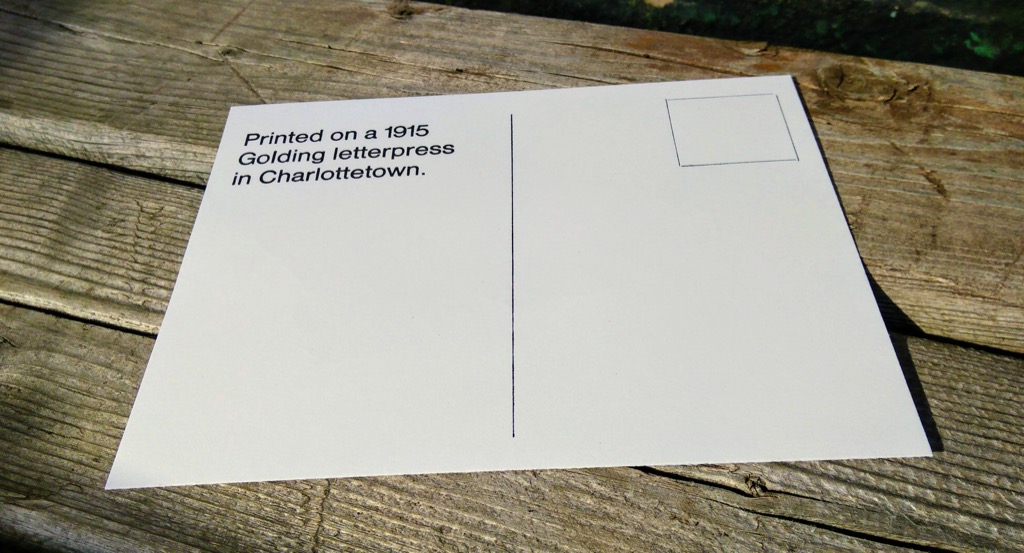
With two sides, and two colours, each postcard took three trips through the Golding Jobber № 8 letterpress to complete. I printed a set of 75, and am pondering what the most appropriate venue for distributing them is.
Exactly at the appointed minute of 1:55 Atlantic today my Android mobile phone went into emergency alert mode, emitting an annoying klaxon-like sound and popping up an “Emergency Alert” notification that it then read out loud to me. This first alert was from the Nova Scotia Emergency Management Office; about 4 seconds later a similar alert came in from the PEI EMO.
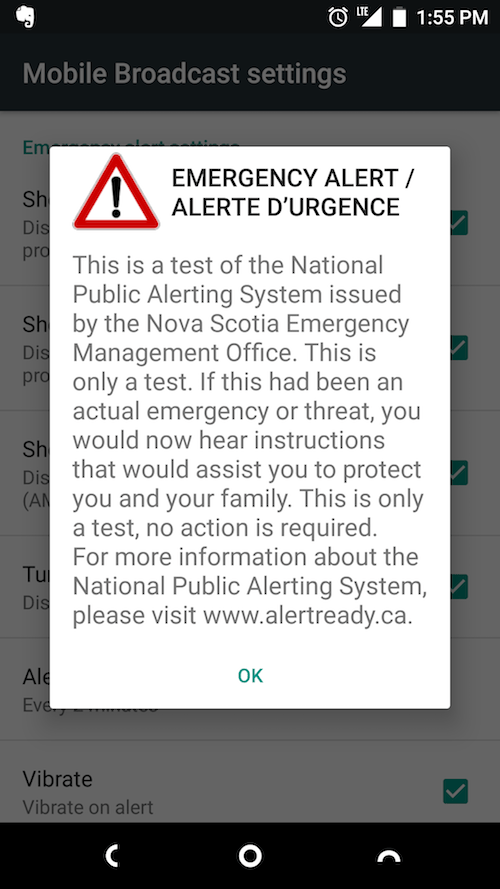 |
 |
I’m note sure why I got the Nova Scotia alert as well as the PEI one, but I’m assuming it has something to do with our shared 902 area code; I don’t begrudge the extra notice, though: if Godzilla is stomping through Truro, I want to know about it so I can batten down the hatches here.
Danny Gregory on the value of embedding yourself in a creative community:
You may think you are not a Van Gogh. But have you gone to Paris? Have you taken advantage of the impact a creative community can make?
Brings to mind Ian Williams’ post I have several criteria, from 2002:
I have several criteria for the places I want to live: as I’ve said before, I want a healthy gay population (even though I’m not gay, I feel more comfortable when the queers are around), an indie bookstore and movie theater, and a coffee shop that serves frappuccino-like crap with whipped cream. Bonus points also go to neighborhoods with ne’er-do-well teens on skateboards, really good basketball hoops with nets, a park within walking distance, and either the view of a large body of water or a mountain. Park Slope has all that stuff except the water or mountain.
But after looking at the map, I’ve hit upon another really good way to pick a place to live, especially in New York: check out the blogs per subway station ratio on the nycbloggers website. I’d say that if you didn’t know anything about the town, simply picking a subway stop that has 10 or more bloggers represented is a good place to start.
These days we can forget that in blogging’s flourishing heyday it was both a solitary act and one conducted in community (albeit community often far-flung).
Voyages in sentence space: prose, demo and code from Robin Sloan. I understand only a sliver, but the notion is fascinating.
Here’s my sentence gradient (I wrote the first and the last; the machines filled in the middle).
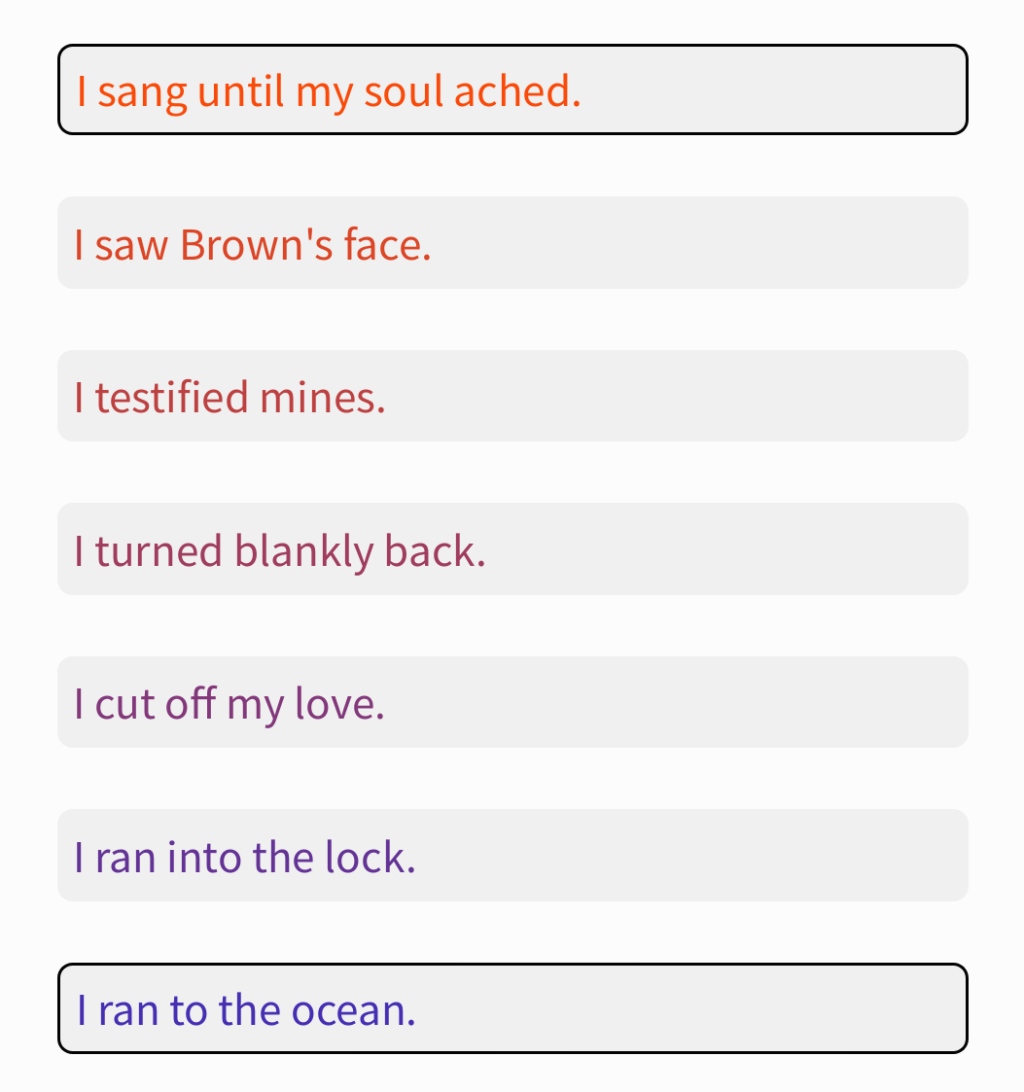
I bought a case of line rule from a chap in Vermont a few years ago, but hadn’t taken it out until yesterday when I used it to prototype the back of a postcard design.
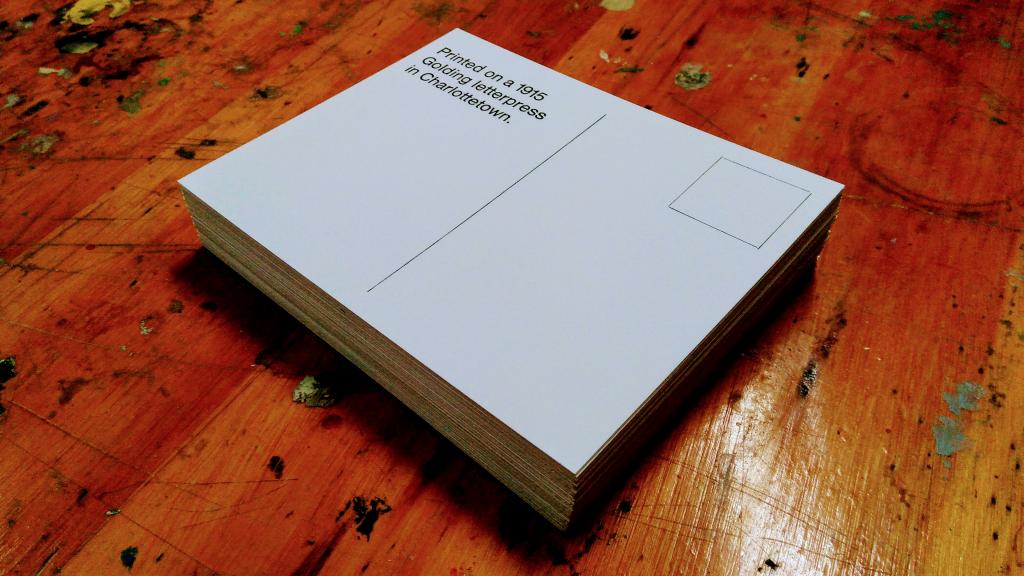
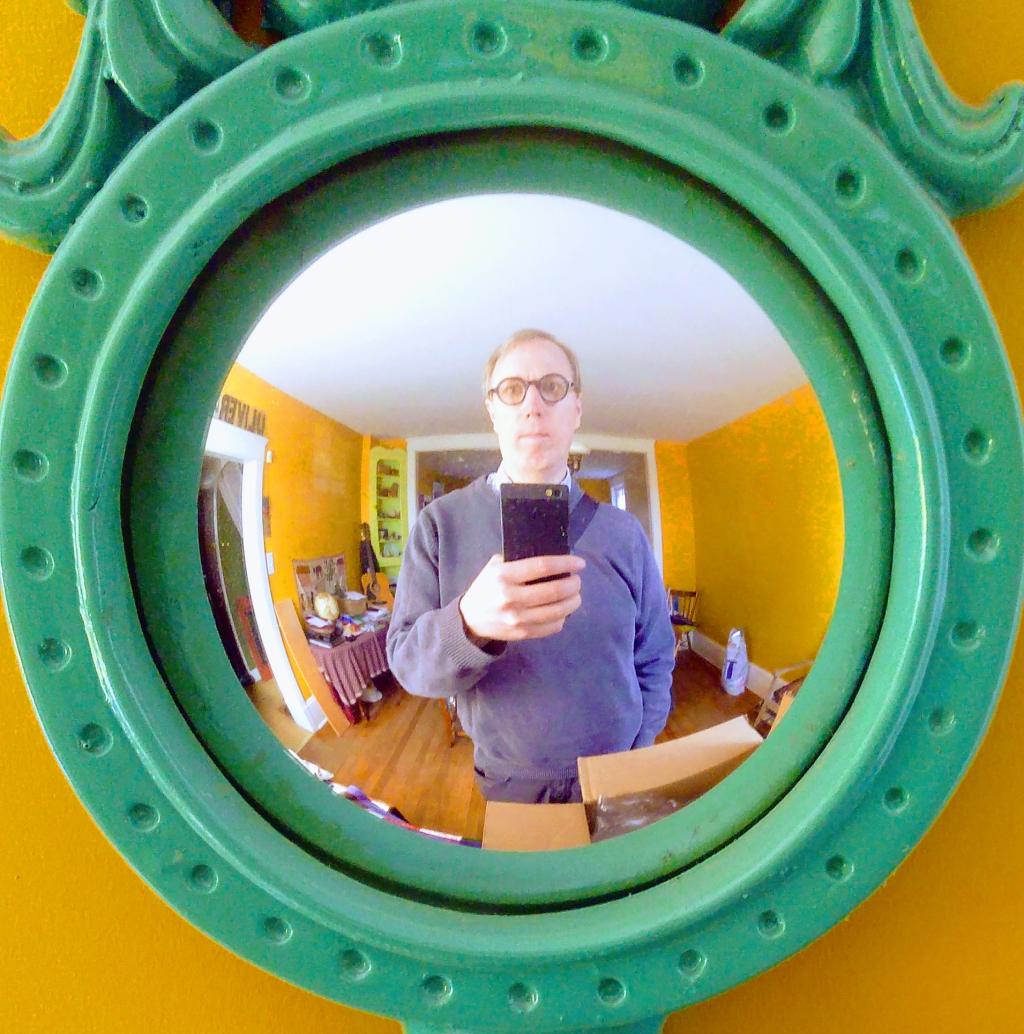
 I am
I am